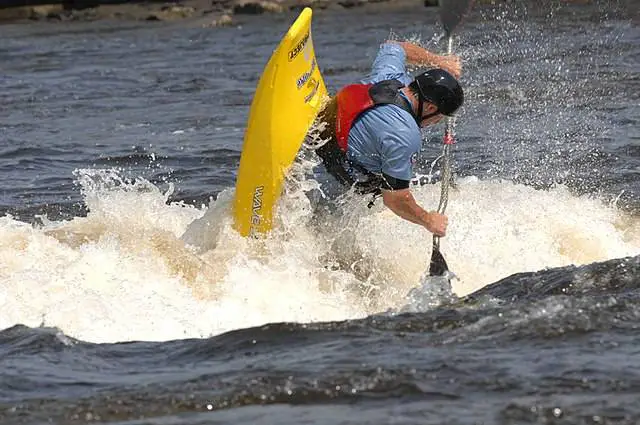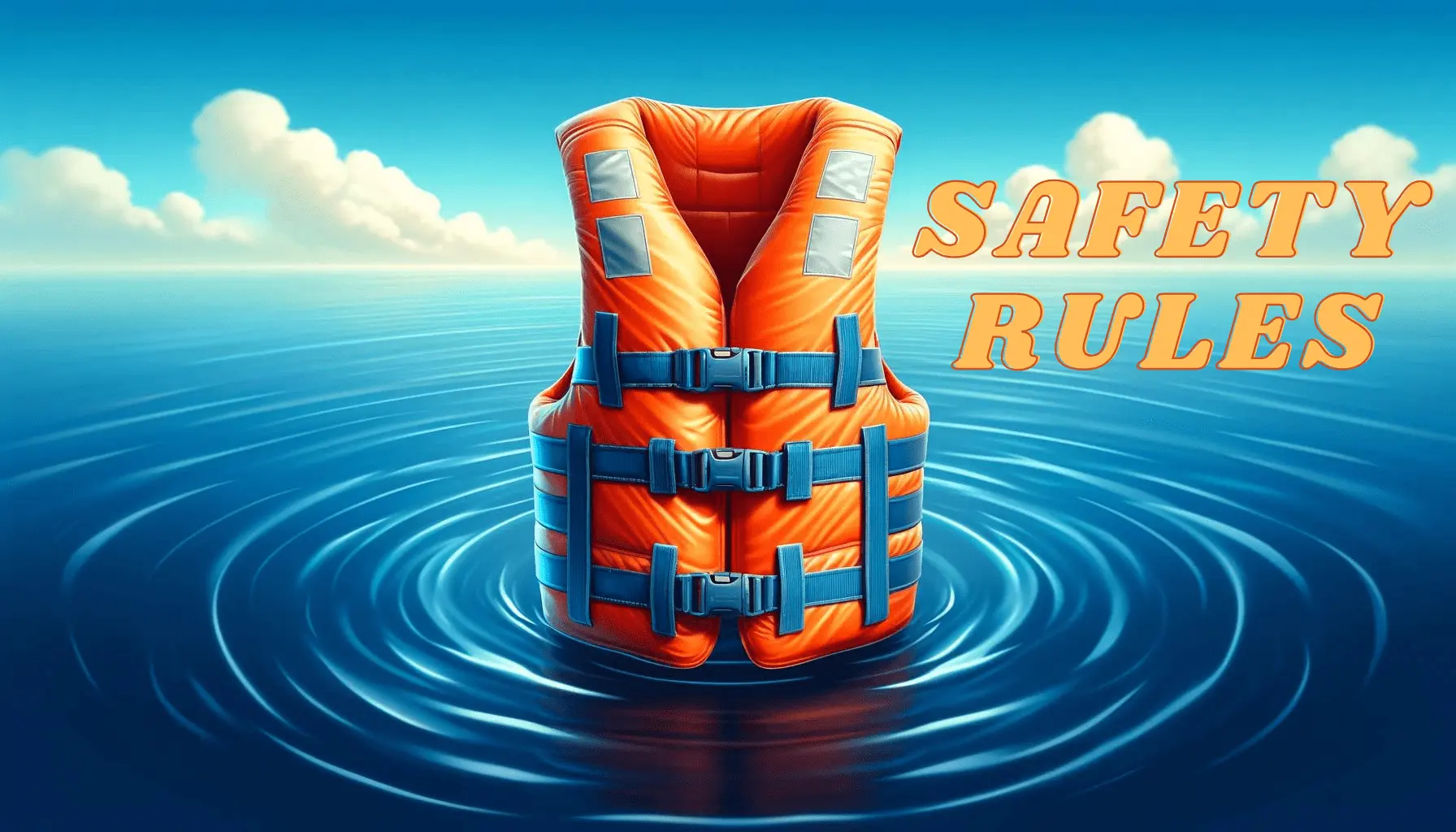Kayaks are long, narrow boats with a narrow bow and stern that have a shallow draft. They have excellent stability due to the fact that kayaks are designed to prevent them from easily flip over. And you steer this type of boat with a double-bladed paddle.
Today, kayaks are very popular because they allow you to go hiking, rafting, rowing, slalom, do extreme sports, and travel on routes that include long crossings on land.
In essence, kayaks are versatile and allow you to get into places that a classic paddle boat would not go.
This is all very appealing, but some kayakers are frightened by one fact. If the kayak flips over, the paddlers often don’t fall out of the kayak like in a regular boat or a sit-on-top kayak. The hull tightly encompasses their body and they are hanging upside down.
This fact seems very risky to some people. But a flip over in a kayak is not as scary as it looks, and kayaks don’t capsize easily.
Above, I will write about how to prevent capsizing and what you have to do if a kayak flips over.

Do kayaks flip over easily?
The answer is: no.
Most of the flips over are a consequence of mistakes and lack of experience. Also, one of the factors that can flip over a kayak is the type of water you are going to paddle on.
You also have to choose the right type of kayak. The whitewater kayak will tip over easily, which gives the paddler the ability to roll or upright the boat as easily as it goes over. This is critical in whitewater. Also, the paddler is more or less sealed in the kayak with a spray skirt.
In flatwater, you want stability, you have a flatter bottom and often an open deck.
How to avoid a kayak capsize
Even in calm water, kayaks can flip over easily if there are inexperienced paddlers on board who either don’t know how to paddle or are paddling at random.
In more difficult waters, the risk of her capsizing increases several times.
Therefore, before boarding the boat, the paddler should put on a life jacket. Pack all belongings in hermetic bags and put them in the boat so that they do not obstruct his movements. I recommend you put your things into hermetic bags so your stuff will be safe in case they fall into the water or the kayak flips over.
If there are two or more crew members, they should discuss and practice their actions in case the kayak flips.
It is important that they are coordinated, because rescuing the boat, belongings, and even the paddlers can become problematic.
In order to minimize the chance of a kayak flipping, you should follow all the rules for using your kayak.
In the kayak, you must not stand up and lean on the sides. And when waves or rough seas appear, you should try to get as low as possible and try to use your legs and hips to regulate the stable position of the kayak on the water.
The weight of the crew members and of all belongings should be evenly distributed over the entire hull area so that the boat does not tip over.
Each crew member should only use a paddle that is perfect for them. And they have to submerge the paddle in the water by about three-quarters of a blade.
The direction and position of the boat should be monitored every second to be able to eliminate even the smallest chance of a flip over of your kayak.
Techniques to prevent a kayak from flipping
There are two major forms of braces that we need to look at. These techniques will help you avoid a flip over in a kayak.
There’s the low brace and the high brace, and both are pretty much the same. In both cases, when the paddle touches the water, you have to slap it and try to push away from it to get the support needed to keep the kayak upright.
With some practice, you should be able to train these techniques to the point where they become an instinctive reaction. And you will be able to avoid any potential loss of balance.
Here below I will let you see a short video with a good explanation of a Low brace and High brace.
Low brace, basic technique to prevent a flip in kayaks
One of my all-time favorite strokes is the anti-capsize stroke. It’s a pretty important stroke and a maneuver that will stop you from capsizing or falling over in your kayak.
Low brace step-by-step
And here you have a step-by-step to practice a low brace and prevent a kayak from flipping over.
- Maintain proper posture and a normal forward grip on the paddle. Keep your knuckles down and your elbows up. Make sure the back surface of the paddle is facing down on the side you are going to lean into. And remind to hold your paddle at your hip. You also need to make sure that the edge of the paddle is slightly higher.
- In the second step, you need to start leaning slightly to the side until you start to fall. After you’ve lost your balance a bit, quickly press the paddle into the water. Keep your paddle horizontal, holding on to it for better support. To regain your balance, you rotate your hip and push your knee against the deck so the kayak tips back into an upright position. You should also note that your head should move toward the side that moves up.
- When you push your upper body backwards to keep your balance, the rotating force will help you a little. The kayak will begin to gradually return to its original position. It will also be much easier if you keep your body close to your hull.
Repeat these steps over and over in calm and shallow water. And don’t forget to practice these techniques on both sides; you won’t always flip on the same side.
High brace, avenced technique to prevent a flip in kayaks
The high brace follows the same rules as the low brace, only you’ll use your paddle in the chin-up position instead of the push-up position. This means that you’ll be using the power face of your paddle against the water.
The high brace technique will allow you to regain your balance even when the kayak tilts heavily to one side.
However, the high brace has the drawback that it is easy to rely on it excessively, which can put your shoulders at risk.
So, despite its name, the first thing to remember is to keep your paddle in your hands low and in front of your body.
High brace step-by-step
Below you have a step-by-step to practice a high brace and prevent a kayak from flipping over.
- Keep the paddle close to your body and hold it with a standard forward grip. It is important to remember that you control your kayak with your feet, so make sure your knees are touching the deck and your heels are firmly on the ground. This will prevent you from falling out of the kayak when you are floating sideways in the water.
- You have to tilt your body to one side until you start to fall. Slightly rotate your upper body so that your back is turned slightly toward the water. This is necessary to create the main force for the brace and to get a wider swing of the paddle.
- Maintain your paddle position above the water. Wait until your upper body loses most of its momentum as you hit the surface. Keep the paddle as horizontal as possible and turn it so that the paddle on the side you are falling from is facing the water. Because if the paddle enters the water vertically, it will not create any resistance to pushing off.
- Your arms and shoulders may feel a lot of pressure in unusual positions. Keep them as low and close to your body as possible. Start by unfolding your upper body and pulling the paddle toward the surface. This will create a supporting force that you can lean on.
- This step should be done as quickly as possible after the previous step. When your body is half submerged in water, it is lighter and therefore does not require as much support from the paddle. Then, keep your upper body in the water while pulling the paddle toward the water. To push the kayak back into an upright position, swing your hips.
- Quickly pull your upper body out of the water after the kayak begins to balance, and continue pushing off the water using the paddle. Your head should come out of the water last. Since it is easier to steer the kayak if you keep your body closer to the center of the kayak. Try to lean toward the back deck if possible.
And voila, you avoided a flip in your kayak. Repeat these steps over and over in calm and shallow water. And don’t forget to practice these techniques on both sides; you won’t always flip on the same side.
What to do if you flip over in a kayak?
The main thing when a kayak flips is to overcome your fear and not let go of the paddle in your hands. It will be kind of a lifeline.
And do not try to immediately save things, because if they are well packed in hermetic bags, they will float.
First of all, you have to save yourself. If a paddle is not in your hands and the hull allows you to move freely, you should just swim out. Then swim up in the kayak, and, pushing it in front of you, get to the shore.
If there are two or more crew members and you flip over on a kayak, the first and most important task of the crew is to hold the paddles and grab the boat.
You can bring the boat back to the normal position directly on the water if there is an opportunity to stand on the bottom of the water. If there is not, you need to grab and try to swim with a kayak to the shore.
How to climb into a kayak in case it flips over
If there are two or more crew members, they can flip the kayak in its normal position on the water. The paddlers have to climb into it from the water as well.
In this case, one of the crew members should hold the stern or bow. Then the other should crawl onto the kayak from the other side, sit on top of the hull, and carefully move his feet inside it.
Then he should sit down comfortably, take a paddle, and, balancing with it, help the other paddler get into the boat.
Who sits first?
To avoid a flip again, the one who sits at the stern of the kayak should take his seat first!
He will have a good view of how his partner climbs into the kayak, which will make it easier to eliminate the roll that occurs.
Experienced paddlers recommend giving the space in the stern to people with a heavier weight; it will be easier to keep the kayak in balance and they can prevent the flip of the kayak.
Once the second crew member is in the kayak, he sits facing forward and starts directing the movement of the boat.
You should tie up the paddle
When you are kayaking, it is advisable to tie all your things to the kayak. Then if the kayak flips over, they will not float all over the water, will not go down, and will stay in the boat.
Also, you have to tie the paddles, which are usually selected strictly individually. When a paddler loses his paddle, it is associated with trouble. And it can happen not only in the case of stormy water but also while traveling in quiet waters.
That’s why it is always better to tie the paddles, even if it is a short trip on a quiet lake near the shore.
Conclusion
After reading this article, you now know how to avoid flipping in a kayak by using the Low brace and High brace techniques. You also learned what to do in case you capsize.
In addiction, you learned that it’s important to tie your things to the hull of the kayak, so you won’t lose them if something happens.
And the answer to our question: Do kayaks flip over easily? And as I wrote earlier, no.
Be careful on the water, follow all safety procedures, try to swim in calm water, and everything will be fine.



